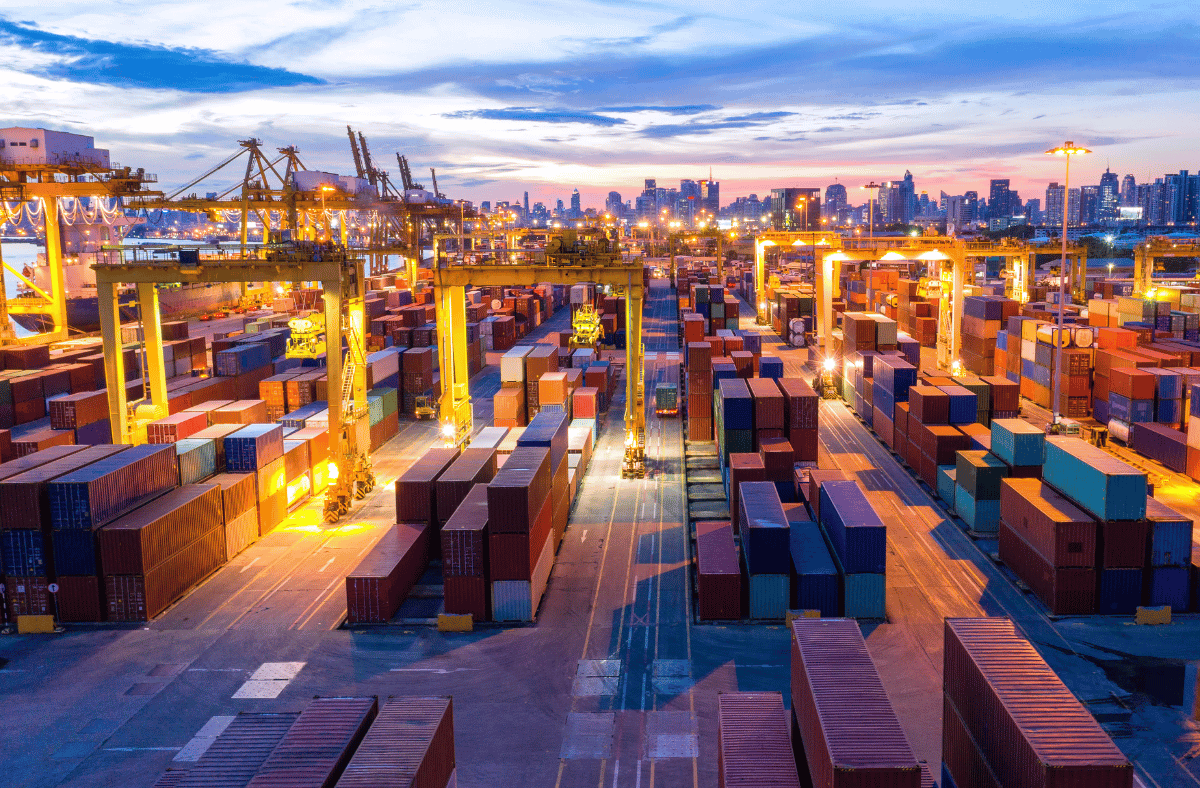
In a recent press release, The WTO (World Trade Organization) predicted that world trade was set for a strong but “uneven recovery” in the aftermath of COVID-19, with the volume of global merchandise trade expected to increase by 8.0% in 2021 after having dropped 5.3% in 2020.
They were also cautious to note: “The relatively positive short-term outlook for global trade is marred by regional disparities, continued weakness in services trade, and lagging vaccination timetables, particularly in poor countries.”
Considering the simultaneous feeling of optimism and uncertainty in the current economic climate, FITT recently hosted an online panel discussion as part of our Challenge and Change series of events to discuss the next phase of business as vaccinations begin to roll out across the world.
For some, there is a light at the end of the tunnel, while others feel they are still very much in the woods, so we turned to a panel of international business experts to draw up useful insights and strategies that businesses could use to move forward in the current climate.
The event, From Reactivity to Adaptability—Advice and Resources for Businesses on the Rebound, explored
- How various industries were faring
- Shipping and supply chain trends
- Risk mitigation strategy for the coming months
- Available businesses support resources, networks, and organizations
- And much, much more.
See what some of the speakers had to say below:
Watch the full event including a LIVE Q&A with the panel below
SME and industry insights, the new normal and innovation in tech
Bernadette Fernandes – Founder & CEO, The Varanda Network

Bernadette’s global business career began in 1986 and has spanned several sectors. She has spent the last 10 years consulting her Varanda Network clients all over the world. She is passionate about helping SMEs develop their export readiness and connect them to business opportunities in markets worldwide.
As circumstances are changing, and many are looking forward to getting back to normal, what type of approach do you think a business can take for preparing for a more normalized market?
Bernadette:
With the exception of travel…we now see a lot of things that we want to do differently or less of, like not having to go into a workplace and, instead, having a more balanced life.
I know some technology companies that are actually now more successful because they are able to offer alternatives to travel. I look at Kognitive Spark, a software company based in New Brunswick where I live, and they’ve seen an increase in clients, applications, target market and revenue because they offer an augmented reality solution with the Microsoft hololens that provides things like maintenance support remotely to onsite staff instead of sending a technician from wherever that expertise happens to be.
Having said that, I do believe that there are many businesses that want to establish some semblance of normal, even if it’s not the normal we were used to. So there are things that businesses are doing or can do to prepare themselves for this new normal—most of which seems to be around digital transformation. To establish or grow an online presence, pivoting and transformation seem to be the things within our control these days, so instead of sending salespeople to tradeshows or to client premises, we’re now relying on e-commerce or social media sales.
Have you seen certain industries faring better than others and should certain types of businesses remain more cautious than others?
Bernadette:
What I know is that overall, in Atlanta Canada, almost 1 in 40 businesses closed and no one could have predicted that. But the good news is that business closures have stabilized and what I’ve seen is businesses overall are now able to operate at their current revenue and expenses for longer periods—albeit, cautiously. But, yes, industries like retail sales, for example, at least in Atlanta Canada, fared better and rebounded quicker after those initial lockdowns. And now they’re seeing increases over even their pre-pandemic levels.
These businesses that were able to move online and curbside quickly, while initially they were hit hard, have now rebounded. And businesses that had a social media or e-commerce presence to begin with—those that were further ahead of the curve than others— were able to accommodate clients that had a need for ongoing products and services regardless of the readiness of their service providers. By contrast, I would say that manufacturing sales in Atlantic Canada, with the exception of New Brunswick, are still below their pre-pandemic levels.
Although they are slowly recovering, New Brunswick has actually seen a rise since the initial pandemic restart, but that’s mainly attributed to the strength of their non-durable industry. So food, beverages, clothing, gasoline, they have all played a positive part in their recovery. In fact, one of the food manufacturers, Mrs Dunster’s, they’re known for their amazing donuts, they actually led the community by example, first by adjusting quickly to safety measures and scaling up production but, also, by collaborating with the technology to create very quickly a platform for online home delivery service with the option of buying for others in need. So, that was a real hurrah moment and I think others followed suit after that.
But, I think, we all know that accommodation and food service businesses have been hit the hardest and even with all the measures they’ve taken to comply, there’s just really no comparison there as far as the oh the business is remaining more cautious than others. I think all types of businesses should proceed with caution or not get too far ahead of themselves. If we look back to last fall, we were already establishing our new normal, and then, bam, there was this introduction of variants, and now, here we are establishing the next normal. So, I think that that’s a strong indication that we really can’t predict anything with this pandemic. I think, from our standpoint, we see a lot of companies have been leveraging the federal government subsidy programs that have really kept a lot of companies and people afloat, but as those programs start to slowly go away that’s when we’re really going to see you know how strong the economy is and how companies are doing.
Risk mitigation strategy and how to best prepare your business for market changes
Enrique Sobalvarro: CITP, Director-at-Large, The GoldMind Project

Enrique is an international trade professional, connector, entrepreneur, strategist, and expert advisor with over 20 years of experience. He is now working as the Director-at-Large for The GoldMind Project. He is also a member of the Advisory Board of the Small Business Initiative at Calgary Catholic Immigration Society and, recently, contributed to Calgary’s post-pandemic recovery as a Business Mentor the Bounceback YYC (a Mount Royal University and the City of Calgary initiative) helping hundreds of entrepreneurs to launch their businesses.
As we are starting to see restrictions ease in some areas around the world, what changes in the approach to risk mitigation and how is that strategy different?
…Being realistic for SMEs no matter where they are, it’s always been difficult to see the big picture somehow and to define a risk mitigation strategy. So, that’s the main reason, basically everyone last year was just reacting. You know, before the pandemic it was really complicated to visualize some risk in some ways, but now, it’s even more difficult. The new strategy for risk mitigation can be defined in three practical elements: The first one is to have a self-evaluation about the current situation of your company, so we can start to asking ourselves some questions like, “Do I really have a risk mitigation plan?” This is the first one. Another question is “Do I have the budget to develop that plan and, if I am already doing business abroad, which areas am I struggling with or will I have a potential struggle with?” That’s one element.
The second is to review the potential risks that we are exposed to in our target markets. We can start with political risks. Political risks, you know, they will establish the risk that we already know about, but there are others that can arise quickly and unexpectedly. A big example of this was the reaction to the pandemic restrictions. I remember, last year, suddenly, we had the order that we had to close. Everyone had to close and do something that was not on their hands. But, right after, we just learned from that lesson. Those lessons from 2020, they’re what we’ll need to consider very much in our risk mitigation plan, as well as the transportation logistic risks. Remember, we had a shortage of goods last year? Things like that taught us to get involved more often with things like having careful scheduling and tracking procedures, having a good talk with your freight forward provider. You need to talk very closely with your logistics and transportation company that you’re you’re working with and you need to ask for their advice as well. So we need to ask ourselves if we have a supply chain assessment needed for your company or not.
We’re facing legal risk as well. We always have to assess this risk every single time, but, right now, everything is going to be still remote. So, put a lot of attention into contracts. There are a lot of international scammers right now, so you need to be aware of that and remember to define your Incoterms® in every single negotiation because this is going to define your responsibility and the other party’s responsibility. These standards will make a strong framework even for your financing options as well.
…You’ll also need to pay attention a little bit more to your letters of credit—the cost of making a bad deal or not paying attention to this. This is huge right now. We need to pay a lot more attention, as well, to quality risk.
We cannot travel to check, for example, how the production process is in some countries. It’s better to hire the services of an independent third-party verification firm like Bureau Veritas or any kind of a firm like that. We need to trust in this kind of services.
The third aspect is, please try to visualize what is happening not only in your country, but globally. We need to be prepared for similar situations like 2020. I’m not suggesting it’s another pandemic but the scenarios in the world can change for many reasons, so the risk mitigation strategy now should focus on paying attention to what is happening all around the world, because if something is going to affect one region and seems like it’s not going to affect other regions—it actually might, like replicating the effects that happened with the pandemic. So, we need to be aware and we need to see the big picture. Ask what’s happening in the world not only your industry but in other industries that could affect your industry indirectly. Also, pay more attention, get informed on SME insights and how to to to get more information and professional advice. These are my suggestions for risk mitigation, right now.
Rahim Mohtaram – Ph.D., Professor at Saskatchewan Polytechnic

Rahim has been working in global supply chains for 15 years and has negotiated and executed more than 155 international contracts in sales, purchasing, agencies and distributors in 25 countries. He is also a CIFFA certified instructor and provides consultation on cost reduction strategies.
The last time we were together on a panel, we talked about smart cost-saving logistics strategies that businesses were employing during the pandemic. Have you seen these strategies change at all in 2021?
Rahim:
Not actually in just logistics but I believe companies are changing their ideas about reducing costs. Some companies are thinking that reducing cost must accompany risk mitigation sometimes we try to reduce the cost but it increases our risk, so companies are trying to pay more attention to risk mitigation compared to cost reduction. For example, we always thought that inventory is somehow poison and it’s not good we have to we have to keep it as low as possible, but nowadays, many companies are trying to keep their supply chains working and they try to keep some safety stock and this is an important point.
The next point is that companies are thinking that this is a chain and the strength of a chain is equal to the strength of the weakest link. They are trying to work with better suppliers, and instead of just shifting the costs
to their suppliers or to their customers, they are trying to remove the cost from the whole supply chain. I mean, we can decrease the cost by removing some additional features, by somehow having some innovative solutions for reducing the cost in the whole supply chain—not just in your own company. Sometimes I’ve just bargained with my supplier and tried to reduce the price with the same quality with the same specifications, but I believe some companies are thinking about removing costs from the whole supply chain.
Procurement and supply chain management are so important to keeping business thriving. What are some practical pieces of advice that you think businesses should take heed of?
The first point, I believe, is that we are encountering a kind of optimism which might not be a kind of realistic decision-making. Try not to be over-optimistic, this is my first point. This optimism might change your forecasting, I believe in this situation. Forecasting is one of the most important activities of each company. Forecasting the demand for casting. The purchasing and everything depends on your forecasts. The reality is that the data of 2020 and the years before that won’t work now and also the data that we had from 2020—the beginning of 2020 up to now—might not work in the next year, so I believe we need some innovative and some new techniques for forecasting and we have to pay more attention to qualitative methods instead of quantitative methods in forecasting. So this is one important challenge, and I believe we need a kind of balanced optimism—not absolute optimism. Do not think that COVID-19 is finished. And, no it’s not finished, but even if it is somehow going to be finished in some countries, our supply chain is a global supply chain and we are dependent on other countries that are still challenging this situation.
The next point is that in these current weeks we have a kind of congestion because of this optimism and we have a shortage in containers. I can say we have some shortages in pallets, it’s unbelievable. Some companies cannot find enough pallets for their products. So, I suggest, try to book sooner. If you want to book a kind of logistics service, if you want to purchase something, try to book sooner.
The other point is that try to work with logistics companies that consider you as their top priority. This is very important. The biggest company in North America might not be the most suitable company for me because I’m not a valuable customer for them. I’m not a big company and I am not their priority. Try to work with the companies that consider you as their top priority.
Another point that I suggest is to try to write mid-term supply contracts and, instead of fixed-price contracts, try to use cost-based pricing strategies in your purchases. If you make long-term relationships or mid-term relationships with your suppliers and make a kind of a loyal relationship with your supplier your risk will be decreased. So I believe cost-based pricing might be a good method for these days.
The next point is to diversify your supply base. Both locally and globally we need some local suppliers I would not suggest that you just come back home and do a resharing or measuring, it’s a complicated decision. But the point is that I believe we need some suppliers in the local market for emergency situations at least.
Another point is try to pay attention to digitizing and making kind of integrated software through your whole supply chain. You need visibility in this situation and you need real-time information. So, we should invest in digitalization and in software, especially for small and medium-sized companies.
The final point is to pay more attention to online negotiation and online business communications. We have to use them more and there are some techniques. They are somehow different from face-to-face negotiations, so we need to train our human resources. And I believe that training is one of the most important duties of managers nowadays. I think FITT has great sources for training our human resources and we can use them.
Smart finance options to carry your business through all conditions, plus the importance of having a documented business plan.
Amesika Baeta, CITP – Senior Account Manager, Export Development Canada (EDC)

As a senior account manager at Export Development Canada, Amesika works with companies of all sizes, of all industries, helping them take their business abroad providing them with trade finance, knowledge and risk mitigation strategies. She has worked in international trade for over 10 years.
Amesika Baeta:
Finances are always top of mind for a lot of SMEs. Though many are looking forward to a normal economy, the truth is that we’re not out of the woods yet. What are some insights you can share with those looking to tread this uneven scenario?
For many, we’re still trying to find ways to access working capital to support their needs. Over the last year, the support for SMEs has quickly changed to adapt to the needs that we see that they need. The reality is that this current economic climate has come, and EDC is one of those agencies where we had to really pivot to figure out how we serve our exporters. Now, in March of last year, the Government of Canada expanded EDC’s mandate to specifically help Canadian companies take on the risk of doing international business. But in times like this, the Canadian government said, no, we need to stretch beyond your mandate to help non-exporting Canadian companies face the financial challenges that they’re experiencing due to the pandemic. As a result, we had to make the necessary changes to adapt and extend some of our focus and our solutions to support needs like this, literally overnight.
We went into problem-solving mode to figure out how does EDC fit into this and what can we do? What are the mechanisms that we have to change to really grow and meet the demands of Canadian companies? So, our goal was to minimize the impact of this pandemic on all businesses—all Canadian businesses. One of the things that we did is create a business credit accessibility program, or what’s most know as the BCAP guarantee program, which is a stepping stone off of another financial guarantee program that we have at EDC that is traditionally for commercial bank clients. So this guarantee program was created in partnership between EDC and Canadian financial institutions to help businesses of all sizes and sectors and all across Canada to address the financial impacts that COVID-19 was having on companies. So, qualified applicants could be quickly approved to help meet their cash flow needs through their bank or credit unions to help manage their day-to-day expenses.
This guarantee is being served through your financial institutions and it is specifically done in new operating lines or term loans, if that’s what your bank has determined in order to really help sustain your operations. So, to pay rent, to pay employees salaries, to, you know, keep the lights on, and to keep operations moving. That program is there to try and help bring the cash into the economy to help companies survive and really, it’s been a program that has been very successful for companies of all sizes and shapes. It’s still available today, so, if you’re not speaking to your bank about it, I would highly recommend going and speaking to them to see whether you qualify.
I must preface that EDC’s program has set parameters and how each bank or credit union applies those parameters differs. So, again, I highly recommend that you and speak to your financial institution and see whether the BCAP guarantee program is a good fit for your cash flow needs. Now, there’s been other things EDC has done. We’ve taken on more credit appetites when it comes to insurance. We’ve made special accommodations to consider if companies had to pivot their business models to sell PPE or start manufacturing PPE and other types of things during the pandemic. So, we’ve made a lot of adjustments to our own regular programs that we provide in order to try to help companies through this pandemic. I welcome people to come to EDC either through the website or online or contact me directly, and I can put you in touch with the appropriate colleagues in the organization to talk through any of those programs to see whether they’re the right fit for your needs right now.
There’s a number of other programs that have been created through our sister crown corporation. Business Development Bank of Canada, there’s provincial programs, federal programs, some municipal programs have all been done to try and help companies survive this pandemic. We’re not out of it yet, so don’t be too proud to go out and ask for what help is out there because that’s the only way that we’re going survive. I also really recommend that you don’t make assumptions as to what you think you are eligible for. Just go and ask an expert to see whether your business could be eligible for these programs. The skilled team at EDC can also answer any kind of trade-related questions that you might have.
If you’re interested in specific COVID-related programs, there are a number of different resources that you can leverage. Virtual tradeshows that you can attend or industry reports or the Canada Export program—that’s run through the Trade Commissioner Service.
In terms of things that I’ve been seeing in my role as an account manager specifically in the GTA region, I’ve seen how important it is for companies to really have a good sense of where they are financially. So, as Enrique mentioned, the importance of having a business plan that addresses what the current needs are—not from when you wrote it, five, 10, or 20 years ago. You may have revamped it for today, and there has never been a time where it has been so needed for companies to make sure they take the time to stop and re-evaluate and readjust themselves as well. And, when it comes to working capital, that is extremely important because your bank is going to be asking for that organization. Any financial institution is asking to see a business plan. One, they want to understand how did you survive the pandemic, what do you do when you had a bad year and because you lost a few clients, that’s ok, but what did you do to pivot? What did you do to counteract that dip in sales? Are things starting to turn around in 2021? Have you had to start selling a different product? Did you move your product online?
We want to know that story as to what your business had to go through, so it’s important that you are building comprehensive financial statements, that you’re keeping interim statements up-to-date and your sales projections. The more organized, the more prepared you are to answer these questions, we’ll only ever be more in your favour and allow you to have more productive conversations with your financial institution.










disqus comments